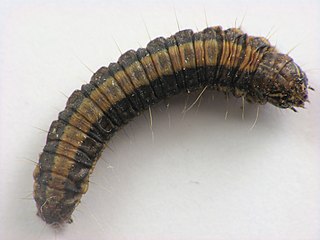
Pyraustinae is a large subfamily of the lepidopteran family Crambidae, the crambid snout moths. It currently includes over 1,400 species; most of them tropical but some found in temperate regions including both North America and Europe.

Spilomelinae is a very species-rich subfamily of the lepidopteran family Crambidae, the crambid snout moths. With 4,135 described species in 344 genera worldwide, it is the most speciose group among pyraloids.

Crambinae is a large subfamily of the lepidopteran family Crambidae, the crambid snout moths. It currently includes over 1,800 species worldwide. The larvae are root feeders or stem borers, mostly on grasses. A few species are pests of sod grasses, maize, sugar cane, rice, and other Poaceae. The monophyly of this group is supported by the structure of the tympanal organs and the phallus attached medially to the juxta, as well as genetic analyses.

Acrobasis is a genus of moths of the family Pyralidae.

Metasia is a genus of moths of the family Crambidae.

Udea is a genus of snout moths in the subfamily Spilomelinae of the family Crambidae. The genus was erected by Achille Guenée in 1845. The currently known 215 species are present on all continents except Antarctica. About 41 species are native to Hawaii.

Hypotia is a genus of moths of the family Pyralidae described by Philipp Christoph Zeller in 1847.

The Chrysauginae are a subfamily of snout moths. They are primarily Neotropical and include about 400 described species.

The Epipaschiinae are a subfamily of snout moths. More than 720 species are known today, which are found mainly in the tropics and subtropics. Some occur in temperate regions, but the subfamily is apparently completely absent from Europe, at least as native species. A few Epipaschiinae are crop pests that may occasionally become economically significant.

Homoeosoma is a genus of moths of the family Pyralidae.

Ancylosis is a genus of snout moth. It was described by Philipp Christoph Zeller in 1839, and is known from South Africa, Uzbekistan, Spain, Turkmenistan, Lebanon, Algeria, Tunisia, Russia, Israel, Palestine, Tinos, Australia, Seychelles, Afghanistan, the United States, Iraq, Namibia, Kazakhstan, Iran, Mauritius, Mozambique, Sarepta, Argentina, Sri Lanka, and Aden.

Pococera is a genus of snout moths in the subfamily Epipaschiinae, found mainly in North and Central America. It was described by Philipp Christoph Zeller in 1848.

Dioryctria is a genus of snout moths. It was described by Philipp Christoph Zeller in 1846.

Euzophera is a genus of snout moths. It was described by Philipp Christoph Zeller in 1867.

The Phycitini are a tribe of moths of the family Pyralidae.

Ematheudes is a genus of snout moths. It was described by Philipp Christoph Zeller in 1867 and is known from Zimbabwe, South Africa, the Democratic Republic of the Congo, Zambia, Namibia, Kenya, Sierra Leone, Seychelles, Iran, Ethiopia, Syria, Hungary, Italy, Angola, Togo and Tunisia.

Pempelia is a genus of moths of the family Pyralidae described by Jacob Hübner in 1825.

Cybalomiinae is a subfamily of the lepidopteran family Crambidae. It was described by Hubert Marion in 1955.

Peoria is a genus of moths of the snout moth family (Pyralidae). The genus was erected by Émile Louis Ragonot in 1887.
















